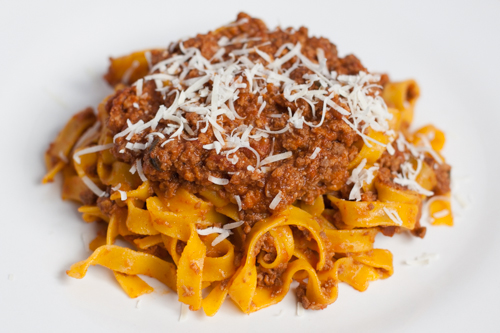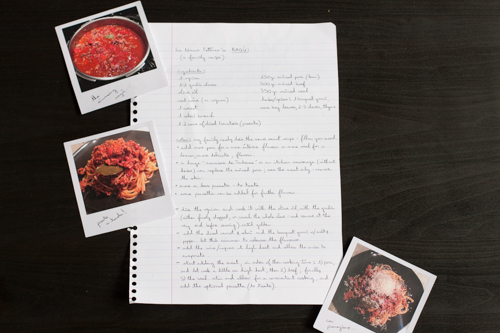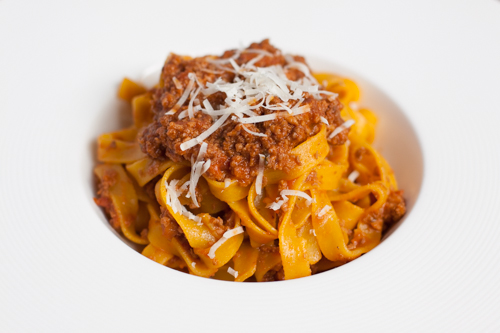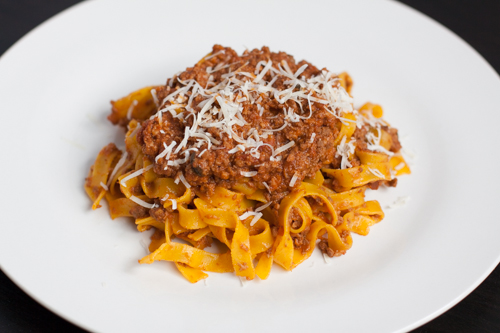La nonna Pettineo's ragu
 Tuesday, May 31, 2016 at 8:23PM
Tuesday, May 31, 2016 at 8:23PM 
For my 30th birthday my friend, Geraldine, sent me a care package from the USA, which included a handwritten recipe and photos of her nonna’s ragu. Like everyone with an Italian grandmother, she says hers makes the best. And like every Italian grandmother, hers doesn’t follow a recipe, so you have to watch her to learn it.
A few years ago, Geraldine and I got into a friendly debate about what constitutes the best ragu and what one should call it. (You can read about that here). I argued with her about it, but mostly for the sake of it. Actually, I was very keen to learn her nonna’s secrets.
When she next visited her, she watched her make it and wrote down all the details step-by-step. The recipe is written in Geraldine’s beautiful cursive handwriting and comes with lots of notes and tips:

My family rarely does the same exact recipe – follow your mood:
- Add more pork for a more intense flavour or more veal for a leaner, more delicate flavour
- A large saucisse de Toulouse or an Italian sausage (without herbs) can replace the minced pork; use the meat only – remove the skin
- More or less passata – to taste
- Some pancetta can be added for a fuller flavour
- Can be made the day prior for the flavours to fully release overnight
I love the sausage trick. I find it gives the ragu a depth of flavour that none of the other suggestions combined can rival. I use it every time now no matter what ragu I am making; lamb, oxtail, beef shin – stick in some pork sausage meat and you’ll have everyone wondering how you got it to taste so goddamn good.
Another great tip is the addition of cloves. I would never have thought to add them, but it really works. For me a good ragu is like a hug on a plate and the warming hint of spice and subtle aroma that the cloves give the dish make for the ultimate spoon.
And I completely agree with her final point – I can’t tell you why but it is a certain fact that slow cooked meat is always better reheated the next day and even better the day after that and better yet the day after that.
So what’s the verdict? Personally, I prefer a ragu that uses whole cuts of meat simmered down till it falls off the bone, but this is definitely the best ragu I’ve had using minced meat. I put this point to Geraldine and she responded:
The minced meat we get is from the butchers: it's still somewhat "chunky”. We only slightly "crush" the mince into the sauce. Not too "mince-y".
I am sure the quality of butcher’s meat in Italy is far superior to the UK, so I’ll give her this.
Traditionally, this ragu would be served with fresh tagliatelle, but Geraldine’s nonna also uses spaghetti and linguine. Geraldine also recommends turning any leftovers into lasagne. (Leftovers? What leftovers!)
Serves 4 greedy people or 6 more restrained people as a main.

Ingredients
2 tbsp olive oil
1 onion, finely diced
2 cloves garlic, finely chopped
1 carrot, finely diced
1 celery stick, finely diced
150ml red wine (or 50ml cognac)
250g minced pork
500g minced beef
350g minced veal
50g pancetta, diced OR 100g pork sausage mince (optional, but advised)
2 x 400g tin chopped tomatoes or 800g passata
1 bouquet garni (bay leaves, parsley, thyme)
2 cloves
Water or stock, as required
Method
Heat the olive oil in a large heavy-based saucepan over a low heat. Add the onion and garlic and sauté gently until soft (approx. 5 minutes). Add the diced carrot and celery and sauté until the carrots and celery are soft (approx. 5 minutes).
Turn the heat up high and add the wine (or cognac) and allow to bubble and reduce for a minute or two.
Add the pork first, then the beef, then the veal and sausage mince or pancetta, if using. Let each cook a little first before adding the next and stir or ‘crush’ with a wooden spoon to break up the mince.
Add the tinned tomatoes or passata (whichever you’re using), bouquet garni and cloves. Reduce the heat to low and simmer for at least 1 hour, but the longer the better. Top up with water or stock as the sauce dries out.
Serve with fresh tagliatelle, linguine or spaghetti and top with grated parmesan.
Bon appetite bellezza!
xx La famiglia Pettineo xx


Reader Comments